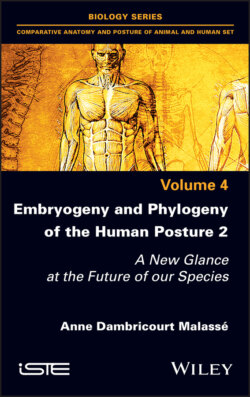Читать книгу Embryogeny and Phylogeny of the Human Posture 2 - Anne Dambricourt Malasse - Страница 16
1.3. Presuppositions 1.3.1. The Neanderthal Man, a stooped posture?
ОглавлениеThe degree of axial straightening of the Neanderthal can finally be compared to Homo sapiens. The base of the skull was not complete, but it was sufficient to compare the angles of verticalization, with the vertebrae and sacrum. The frontal curvature seemed to be lower than in Homo sapiens because of the particularly pneumatized (“inflated”) supraorbital torus above the orbits, the adult facial block was in front of the frontal lobes and not below them as in the Cro-Magnon Man. The brain was more voluminous, but the impressions of the lobes were different and the prefrontal cortex was especially less developed. The cerebellar lobe was clearly higher than that of the Cro-Magnon Man, it was also smaller in absolute value and in relative value to the brain, which corresponded to a less verticalized clivus and a more open sphenoidal angle. The face was prognathic, the mandible had no chin. The geometric protocols in the median sagittal plane confirmed a general straightening movement, but it was not as pronounced as in Homo sapiens (Figures 13 and 14 in Boule (1911–1913)). The reconstitution of the profile of the spine with isolated vertebrae did not show cervical and lumbar lordosis (forward curvature), so it was not sinusoidal like Homo sapiens. The femurs were curved, more stocky.
The curvature of the femurs gave the impression of a body in a forward bent position, which was accentuated on the La Chapelle-aux-Saints Man due to a congenital dislocation of the left hip, but which really did exist and was systematically found in Neanderthal patients. The general conformation of the skull with high neck and facial prognathism, as well as the slightly flexed profile of the thighs, gave a general cranio-spinal appearance intermediate between that of the great ape and Homo sapiens. Neanderthal Man thus appeared to be less vertical and less cerebralized than the Cro-Magnon Man. The appearance reflected an anatomy and cerebral development of an evolutionary stage preceding that of Homo sapiens. However, Boule did not venture to interpret the brain’s imprints in terms of cognitive capacities beyond what would be possible with analogies with pathological conditions of current Homo sapiens.
